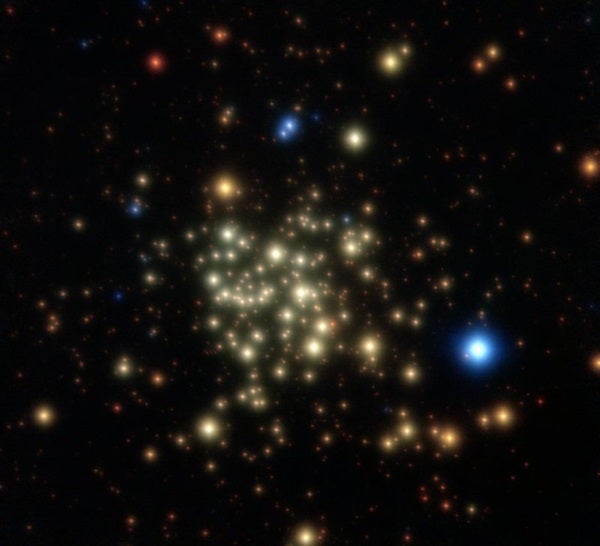Using the European Southern Observatory’s (ESO) Very Large Telescope (VLT), astronomers have obtained one of the sharpest views of the Arches Cluster — an extraordinary dense cluster of young stars near the supermassive black hole at the heart of the Milky Way. Despite the extreme conditions, astronomers were surprised to find the same proportions of low- and high-mass young stars in the cluster as are found in more tranquil locations in our Milky Way.
The massive Arches Cluster is a rather peculiar star cluster. It is located 25,000 light-years away toward the constellation Sagittarius and contains about a thousand massive young stars less than 2.5 million years old. It is an ideal laboratory to study how massive stars are born in extreme conditions as it is close to the center of our Milky Way, where it experiences huge opposing forces from stars, gas, and a supermassive black hole. The Arches Cluster is 10 times heavier than typical young star clusters scattered throughout the Milky Way, and it is enriched with chemical elements heavier than helium.
Using the Nasmyth Adaptive Optics System and the Near-Infrared Imager and Spectrograph (NaCo) on ESO’s VLT, located in Chile, astronomers scrutinized the cluster in detail. Thanks to adaptive optics, astronomers can remove most of the blurring effect of the atmosphere, and the new NaCo images of the Arches Cluster are crisper than those obtained with telescopes in space. Observing the Arches Cluster is very challenging because of the huge quantities of absorbing dust between Earth and the galactic center, which visible light cannot penetrate. This is why astronomers used NaCo to observe the region in near-infrared light.
The new study confirms that the Arches Cluster is the densest cluster of massive young stars known. It is about 3 light-years across with more than a thousand stars packed into each cubic light-year — a density a million times greater than in the Sun’s neighborhood.
Astronomers studying clusters of stars have found that higher-mass stars are rarer than their less-massive counterparts, and their relative numbers are the same everywhere. For many years, the Arches Cluster seemed to be a striking exception.
“With the extreme conditions in the Arches Cluster, one might imagine that stars won’t form in the same way as in our quiet solar neighborhood,” said Pablo Espinoza from the Steward Observatory at the University of Arizona in Tucson. “However, our new observations showed that the masses of stars in this cluster actually do follow the same universal law.”
In this image, the astronomers could also study the brightest stars in the cluster. “The most massive star we found has a mass of about 120 times that of the Sun,” said Fernando Selman from ESO, Garching, Germany. “We conclude from this that if stars more massive than 130 solar masses exist, they must live for less than 2.5 million years and end their lives without exploding as supernovae, as massive stars usually do.”
The total mass of the cluster seems to be about 30,000 times that of the Sun, much more than previously thought. “That we can see so much more is due to the exquisite NaCo images,” said co-author Jorge Melnick from ESO, Garching, Germany.










